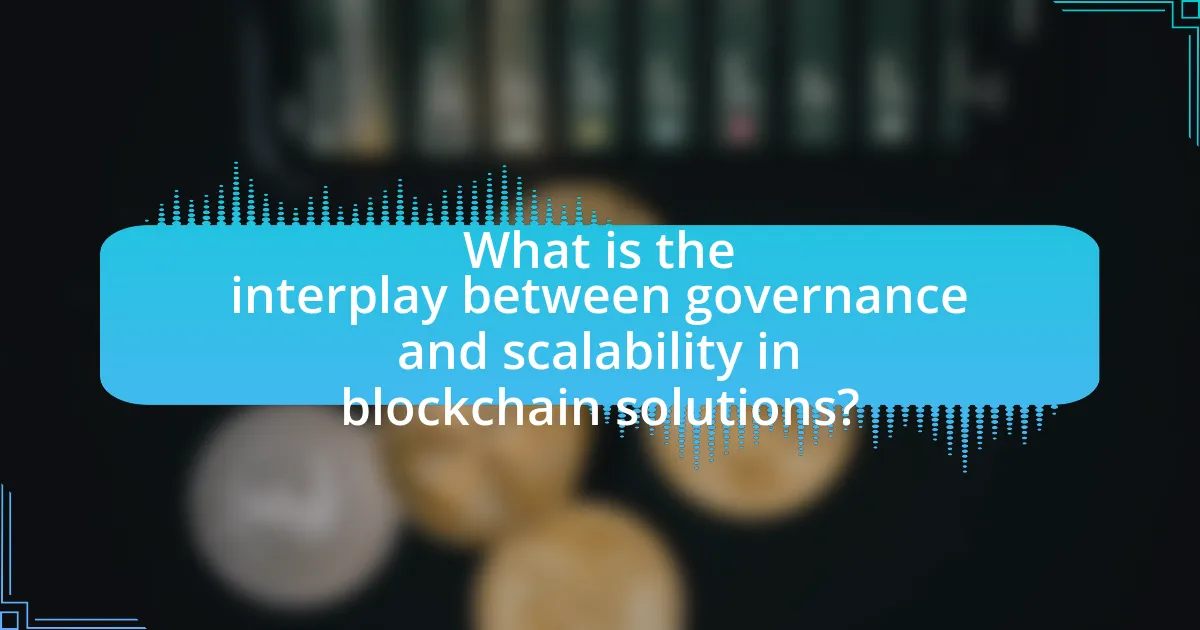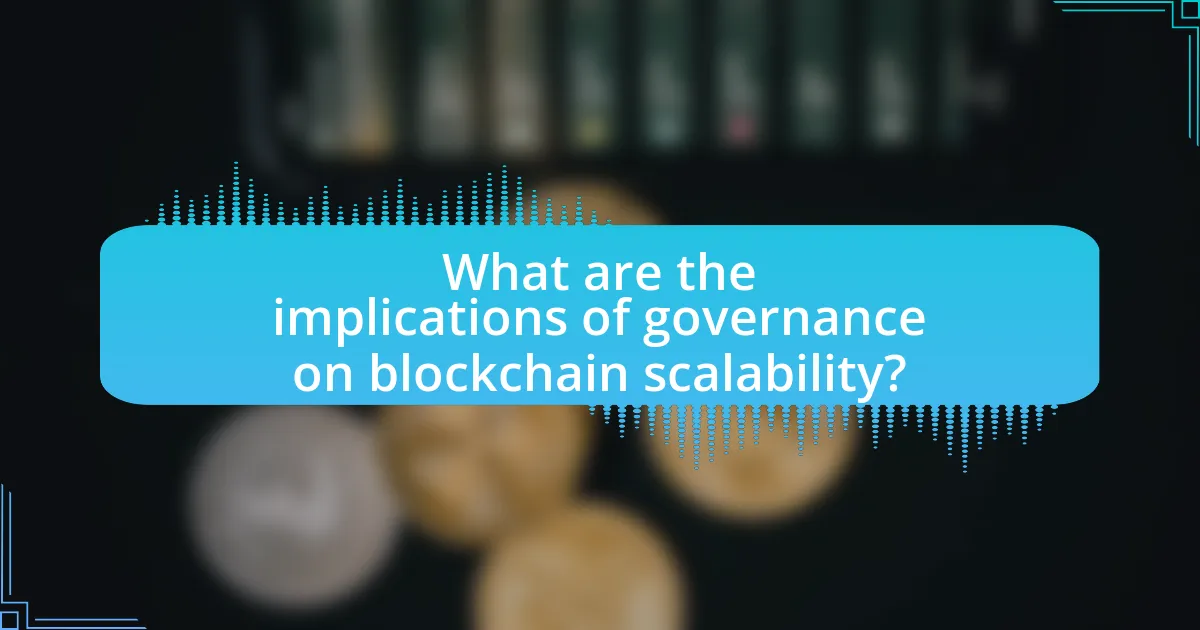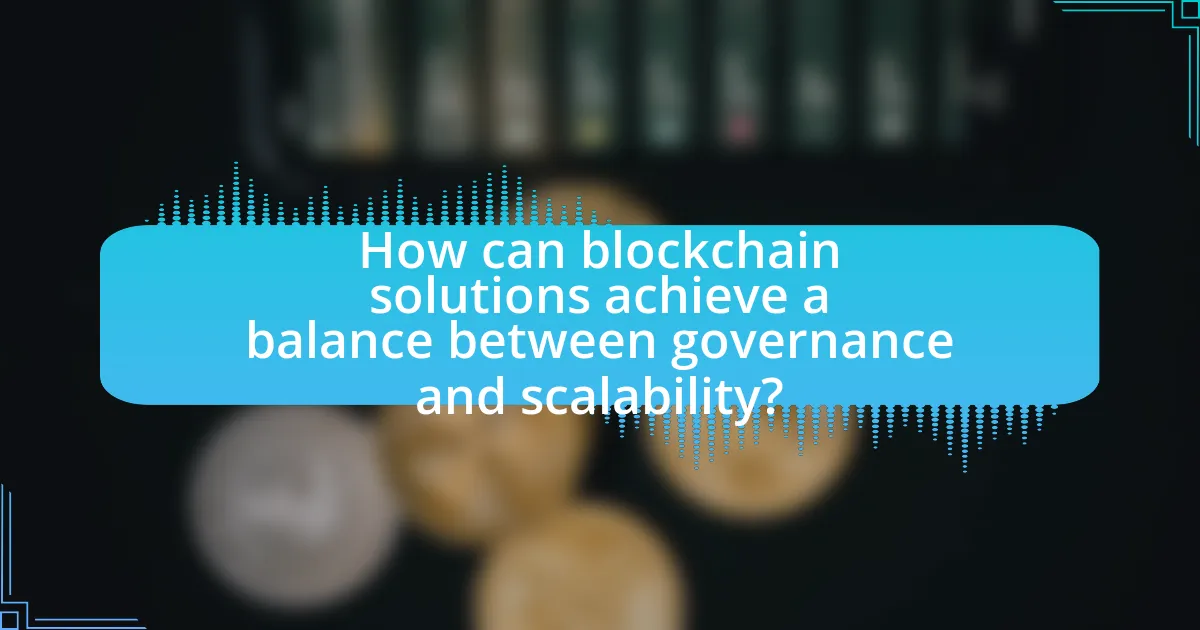The article analyzes the interplay between governance and scalability in blockchain solutions, emphasizing how governance structures influence decision-making processes and resource allocation, which in turn affects a blockchain’s ability to scale. It discusses various governance models, including on-chain, off-chain, and hybrid approaches, and their respective impacts on transaction throughput and network performance. The article also highlights the critical role of effective governance in addressing scalability challenges, the trade-offs between decentralization and scalability, and the importance of stakeholder engagement and transparency in enhancing governance outcomes. Additionally, it explores future trends and practical strategies for organizations to improve governance and scalability in blockchain systems.

What is the interplay between governance and scalability in blockchain solutions?
The interplay between governance and scalability in blockchain solutions is characterized by the need for effective decision-making processes that can adapt to increasing transaction volumes. Governance structures, such as consensus mechanisms and protocol upgrades, directly influence how a blockchain can scale; for instance, a decentralized governance model may slow down decision-making, hindering timely scalability improvements. Conversely, a well-defined governance framework can facilitate rapid scalability by enabling swift consensus on necessary changes, as seen in projects like Ethereum, which has implemented governance changes to enhance its scalability through upgrades like Ethereum 2.0. Thus, the relationship between governance and scalability is crucial, as effective governance can lead to improved scalability, while poor governance may restrict a blockchain’s ability to grow and adapt.
How do governance models influence scalability in blockchain systems?
Governance models significantly influence scalability in blockchain systems by determining decision-making processes and resource allocation. For instance, centralized governance can facilitate rapid consensus and implementation of scalability solutions, such as increasing block size or adjusting transaction fees, leading to immediate performance improvements. In contrast, decentralized governance often involves more complex consensus mechanisms, which can slow down decision-making and hinder timely scalability enhancements. A study by the Cambridge Centre for Alternative Finance highlights that blockchains with more streamlined governance structures, like those seen in some permissioned networks, can achieve higher transaction throughput compared to those with extensive decentralized governance frameworks. This demonstrates that the efficiency and structure of governance directly impact a blockchain’s ability to scale effectively.
What are the key governance models used in blockchain?
The key governance models used in blockchain include on-chain governance, off-chain governance, and hybrid governance. On-chain governance involves decision-making processes that are embedded within the blockchain protocol itself, allowing stakeholders to vote on changes directly through the network, as seen in projects like Tezos. Off-chain governance relies on external mechanisms, such as community discussions and consensus among stakeholders, without formal voting on the blockchain, exemplified by Bitcoin’s governance approach. Hybrid governance combines elements of both on-chain and off-chain models, allowing for flexibility and adaptability, as demonstrated by projects like Ethereum, which utilizes both community consensus and protocol-level changes. These models are essential for addressing scalability and ensuring that blockchain networks can evolve effectively while maintaining stakeholder engagement.
How does each governance model impact scalability?
Each governance model impacts scalability by influencing decision-making processes, resource allocation, and network participation. For instance, centralized governance can enhance scalability by enabling rapid decision-making and streamlined updates, as seen in platforms like Ripple, which can process transactions quickly due to its controlled structure. Conversely, decentralized governance may hinder scalability due to the need for consensus among a larger group of stakeholders, as evidenced by Ethereum’s challenges in scaling during high demand periods, where network congestion occurs due to the requirement for broad agreement on changes. Thus, the governance model directly affects how efficiently a blockchain can scale to accommodate increased usage and transaction volume.
Why is scalability a critical factor in blockchain governance?
Scalability is a critical factor in blockchain governance because it directly impacts the network’s ability to handle increased transaction volumes and user participation. As blockchain networks grow, effective governance mechanisms must adapt to ensure that decision-making processes remain efficient and inclusive. For instance, Ethereum’s transition to a proof-of-stake model aims to enhance scalability while maintaining governance effectiveness, as evidenced by its ability to support a larger number of transactions per second compared to its previous proof-of-work model. This adaptability is essential for sustaining user trust and engagement, which are vital for the long-term success of any blockchain ecosystem.
What challenges do scalability issues pose for governance?
Scalability issues pose significant challenges for governance by hindering decision-making processes and reducing the effectiveness of governance structures. When a blockchain network cannot efficiently handle an increasing number of transactions, it leads to delays and increased costs, which complicate the governance of that network. For instance, in Ethereum, scalability limitations have resulted in high gas fees and slow transaction times during peak usage, making it difficult for stakeholders to participate in governance activities such as voting or proposing changes. This inefficiency can lead to a lack of engagement from the community, undermining the legitimacy and responsiveness of governance mechanisms.
How can effective governance address scalability challenges?
Effective governance can address scalability challenges by establishing clear frameworks and protocols that facilitate decision-making and resource allocation. These frameworks enable organizations to adapt to increasing demands by streamlining processes, ensuring compliance, and fostering collaboration among stakeholders. For instance, the implementation of decentralized governance models in blockchain networks, such as those seen in Ethereum’s governance proposals, allows for community-driven decisions that can quickly adapt to scalability needs, thereby enhancing the network’s capacity to handle more transactions efficiently. This adaptability is crucial as it directly correlates with the ability to scale operations without compromising performance or security.

What are the implications of governance on blockchain scalability?
Governance significantly impacts blockchain scalability by determining decision-making processes and protocol upgrades. Effective governance structures can facilitate timely consensus on necessary changes, enabling networks to adapt and scale efficiently. For instance, the Ethereum network’s transition from Proof of Work to Proof of Stake illustrates how governance decisions can enhance scalability by improving transaction throughput and reducing energy consumption. Conversely, poor governance can lead to stagnation, as seen in networks that struggle to reach consensus on upgrades, ultimately hindering their ability to scale and meet user demands.
How do different governance structures affect transaction throughput?
Different governance structures significantly affect transaction throughput by influencing decision-making processes, consensus mechanisms, and network efficiency. For instance, decentralized governance models, such as those used in Ethereum, allow for community-driven decisions that can adapt to changing needs, potentially enhancing throughput by enabling quicker updates and optimizations. In contrast, centralized governance structures, like those seen in traditional financial systems, may impose stricter controls and slower decision-making, which can bottleneck transaction processing. Research indicates that blockchain networks with more flexible governance structures can achieve higher transaction speeds; for example, the EOS blockchain, which employs a delegated proof-of-stake mechanism, can process thousands of transactions per second due to its efficient governance model. Thus, the type of governance structure directly correlates with the network’s ability to handle transactions effectively.
What role does consensus mechanism play in scalability?
The consensus mechanism is crucial for scalability in blockchain systems as it determines how transactions are validated and added to the blockchain. A more efficient consensus mechanism can process a higher number of transactions per second, thereby enhancing the overall throughput of the network. For instance, proof-of-stake mechanisms can achieve greater scalability compared to traditional proof-of-work systems, as they require less computational power and can finalize transactions faster. This efficiency is evidenced by Ethereum’s transition to proof-of-stake, which aims to significantly increase its transaction capacity and reduce latency.
How do governance decisions impact network performance?
Governance decisions significantly impact network performance by determining the rules and protocols that guide network operations. Effective governance can enhance performance by ensuring efficient resource allocation, optimizing consensus mechanisms, and facilitating timely upgrades. For instance, a study by Catalini and Gans (2016) in “The Economic Case for Blockchain” highlights that well-structured governance frameworks can lead to faster transaction processing and improved scalability, as they enable quicker decision-making and adaptability to changing conditions. Conversely, poor governance can result in delays, increased costs, and reduced trust among participants, ultimately hindering network efficiency and scalability.
What are the trade-offs between decentralization and scalability in governance?
Decentralization in governance enhances transparency and reduces the risk of centralized power abuse, while scalability allows systems to handle increased loads efficiently. However, the trade-off lies in the fact that highly decentralized systems often struggle with scalability due to the need for consensus among numerous nodes, which can slow down decision-making and transaction processing. For instance, Bitcoin’s decentralized model limits transaction throughput to approximately seven transactions per second, while centralized systems like Visa can handle over 24,000 transactions per second. This illustrates that while decentralization promotes security and trust, it can hinder the ability to scale effectively, leading to potential bottlenecks in governance processes.
How does decentralization influence governance effectiveness?
Decentralization enhances governance effectiveness by distributing power and decision-making authority across multiple stakeholders rather than concentrating it in a single entity. This distribution fosters greater transparency, accountability, and responsiveness to local needs, as seen in blockchain governance models where community participation is integral to decision-making processes. For instance, research by Zohar and Rosenberg (2018) highlights that decentralized governance structures in blockchain systems lead to improved stakeholder engagement and trust, ultimately resulting in more effective governance outcomes.
What are the potential risks of prioritizing scalability over governance?
Prioritizing scalability over governance can lead to significant risks, including reduced accountability, increased vulnerability to attacks, and potential regulatory non-compliance. When scalability is emphasized, governance structures may become weak or neglected, resulting in a lack of oversight and transparency. This can facilitate malicious activities, as seen in cases like the DAO hack in 2016, where governance failures allowed for exploitation. Additionally, without proper governance, organizations may struggle to meet regulatory requirements, leading to legal repercussions and loss of trust among stakeholders.

How can blockchain solutions achieve a balance between governance and scalability?
Blockchain solutions can achieve a balance between governance and scalability by implementing layered architectures and adaptive consensus mechanisms. Layered architectures, such as those seen in Ethereum 2.0, allow for off-chain transactions to reduce the load on the main chain, thereby enhancing scalability while maintaining governance through on-chain protocols. Adaptive consensus mechanisms, like Delegated Proof of Stake, enable a more flexible governance structure that can adjust to network demands without sacrificing transaction speed or security. These approaches have been validated by projects like Polkadot, which successfully integrates governance and scalability through its parachain model, allowing multiple blockchains to operate in parallel while adhering to a unified governance framework.
What best practices can be implemented for effective governance in scalable blockchain solutions?
Effective governance in scalable blockchain solutions can be achieved through the implementation of decentralized decision-making, transparent protocols, and adaptive regulatory frameworks. Decentralized decision-making empowers stakeholders by distributing authority, which enhances participation and trust, as evidenced by successful models like Ethereum’s governance structure. Transparent protocols ensure that all participants have access to the same information, fostering accountability and reducing the risk of manipulation, as demonstrated by the open-source nature of many blockchain projects. Adaptive regulatory frameworks allow for flexibility in governance, accommodating technological advancements and user needs, which is crucial for maintaining relevance and compliance in a rapidly evolving landscape.
How can stakeholder engagement enhance governance and scalability?
Stakeholder engagement enhances governance and scalability by fostering collaboration and transparency among all parties involved. When stakeholders actively participate in decision-making processes, they contribute diverse perspectives that lead to more informed governance structures. This inclusivity can result in policies that are better aligned with the needs of the community, thereby increasing trust and compliance. Furthermore, engaged stakeholders can identify scalability challenges early, allowing for proactive solutions that facilitate growth. For instance, research by the World Economic Forum indicates that organizations with high stakeholder engagement report 20% higher satisfaction rates, which correlates with improved operational efficiency and scalability.
What role does transparency play in governance and scalability?
Transparency is crucial in governance and scalability as it fosters trust and accountability among stakeholders. In blockchain solutions, transparency ensures that all transactions and governance decisions are visible and verifiable, which enhances user confidence and encourages participation. For instance, a study by the World Economic Forum highlights that transparent governance mechanisms can lead to increased user engagement and adoption rates, thereby improving scalability. Furthermore, transparency allows for real-time monitoring and auditing, which can identify inefficiencies and facilitate timely adjustments, ultimately supporting the scalability of blockchain networks.
What future trends may influence the relationship between governance and scalability in blockchain?
Future trends that may influence the relationship between governance and scalability in blockchain include the rise of decentralized autonomous organizations (DAOs), advancements in layer-2 scaling solutions, and the integration of regulatory frameworks. DAOs enable community-driven governance, which can enhance scalability by allowing more efficient decision-making processes. Layer-2 solutions, such as rollups and state channels, improve transaction throughput while maintaining governance structures, thus addressing scalability challenges. Additionally, as regulatory bodies develop clearer guidelines for blockchain operations, governance models may adapt to ensure compliance, which can further impact scalability by necessitating more robust governance mechanisms to manage regulatory requirements effectively.
How might emerging technologies impact governance models?
Emerging technologies significantly impact governance models by enabling decentralized decision-making and enhancing transparency. For instance, blockchain technology facilitates trustless interactions among stakeholders, allowing for more democratic governance structures where participants can vote on proposals directly, as seen in decentralized autonomous organizations (DAOs). Additionally, the use of artificial intelligence in governance can streamline processes and improve data-driven decision-making, evidenced by cities implementing AI for resource allocation and urban planning. These technologies collectively reshape traditional governance frameworks, promoting efficiency and inclusivity.
What are the anticipated challenges for governance and scalability in the next decade?
Anticipated challenges for governance and scalability in the next decade include regulatory uncertainty, technological fragmentation, and the need for interoperability among blockchain networks. Regulatory uncertainty arises as governments worldwide grapple with how to classify and regulate blockchain technologies, potentially stifling innovation and creating compliance burdens. Technological fragmentation occurs due to the rapid development of diverse blockchain protocols, which can lead to inconsistencies in governance models and hinder scalability efforts. Additionally, the need for interoperability is critical, as disparate systems must communicate effectively to ensure seamless transactions and data sharing, which is essential for scaling blockchain solutions. These challenges are supported by ongoing discussions in industry reports, such as the World Economic Forum’s “Blockchain Beyond the Hype,” which highlights the importance of cohesive governance frameworks and scalable architectures for the future of blockchain technology.
What practical strategies can organizations adopt to improve governance and scalability in blockchain solutions?
Organizations can adopt several practical strategies to improve governance and scalability in blockchain solutions, including implementing a multi-layer governance framework, utilizing off-chain solutions for transaction processing, and establishing clear consensus mechanisms. A multi-layer governance framework allows for differentiated decision-making processes that can adapt to various stakeholder needs, enhancing accountability and transparency. Off-chain solutions, such as state channels or sidechains, can significantly reduce the load on the main blockchain, thereby improving transaction speed and scalability. Clear consensus mechanisms, like proof of stake or delegated proof of stake, can streamline decision-making and reduce the energy consumption associated with traditional proof of work systems, further supporting scalability. These strategies are supported by case studies showing that organizations employing multi-layer governance and off-chain solutions have successfully increased transaction throughput while maintaining robust governance structures.

















